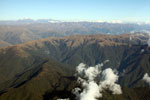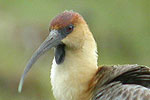View Larger MapSierra de Juárez in Oaxaca is one of the most important cloud forests in Mexico, but remains unprotected.
Mexico could lose nearly 70 percent of its cloud forests due to climate change by 2080, according to new research published in Nature Climate Change, that has implications for cloud forests worldwide.
“Given the narrow environmental tolerance of cloud forests, the fear is that human-induced climate change could constitute an even greater peril [than deforestation] in the near future,” says lead author Rocio Ponce-Reyes of the ARC Center of Excellence for Environmental Decisions (CEED) and The University of Queensland in a press release. Cloud forests are usually defined as tropical forests growing at an altitude of more than 6,600-10,000 feet (2,500-3,000 meters) in elevation, where the forest receives most of its moisture from fog. Unique ecosystems, cloud forests harbor many species found no-where else including a wide variety of orchids, hummingbirds, and amphibians.
Researchers found that rising temperatures and climatic changes could devastate 11,685 square kilometers of Mexico cloud forest, equaling 69 percent of the whole biome at present. However the news gets even worse: most of Mexico’s cloud forest (88 percent) remains unprotected and vulnerable to deforestation and degradation. If the unprotected forests are cleared and climate change impacts the rest as predicted, Mexico may lose 99 percent of its cloud forest and lose most of its species.
The researchers write that “immediate action” is needed to protect cloud forests that appear most resilient to climate change impacts.
“Our analysis indicates that one key area for immediate protection is the Sierra de Juárez in Oaxaca. This area supports many endemic species and is expected to retain relatively large fragments of cloud forest despite rapid climate change,” the researchers write. Currently 22 endangered species are found in the Sierra de Juárez.
“If bold measures are not taken very soon to reduce the concentration of greenhouse gases, these forests are unlikely to survive in their present form, with anything near their present diversity, very far into the twenty-first century,” the scientists warn.
The study raises larger questions about cloud forests worldwide: if 69 percent of Mexico’s cloud forests are vulnerable to climate change, what about other cloud forests found in Central America, South America, sub-Saharan Africa, Southeast Asia, and the Malay Archipelago?
Unfortunately, despite harboring a wealth of endemic and undiscovered species, cloud forests remain little studied by researchers, and they are vanishing rapidly due to conversion for crops and pasture as well as logging.
CITATION: Rocío Ponce-Reyes, Víctor-Hugo Reynoso-Rosales, James E. M. Watson, Jeremy Van Der Wal, Richard A. Fuller, Robert L. Pressey and Hugh P. Possingham. Vulnerability of cloud forest reserves in Mexico to climate change. Nature Climate Change. 2012.
Related articles
3 new private conservation reserves established by communities in Peru
(03/21/2012) Three new private conservation areas in the Amazon-Andes region of Peru will help buffer the country’s national park system while offering new opportunities for local people to benefit from protecting ecosystems.
Majority of Andes’ biodiversity hotspots remain unprotected

(02/01/2012) Around 80 percent of the Andes’ most biodiverse and important ecosystems are unprotected according to a new paper published in the open-access journal BMC Ecology. Looking at a broad range of ecosystems across the Andes in Peru and Bolivia, the study found that 226 endemic species, those found no-where else, were afforded no protection whatsoever. Yet time is running out, as Andean ecosystems are undergoing incredible strain: a combination of climate change and habitat destruction may be pushing many species into ever-shrinking pockets of habitat until they literally have no-where to go.
Volcano and cloud forests conserved in Ecuador

(12/05/2011) Conservation organizations and the Ecuadorian government have succeeded in securing over 250,000 acres (106,000 hectares) of cloud forest and grasslands surrounding the Antisana Volcano for protection. The area, long-used for cattle ranching, is home to Andean condors (Vultur gryphus), cougars (Puma concolor), Andean fox (Lycalopex culpaeus), silvery grebes (Podiceps occipitalis), black-faced ibis (Theristicus melanopis), spectacled bear (Tremarctos ornatus), and three species of endangered frogs. The protected area stretches from 3,900 feet (1,188 meters) to 18,700 feet (5,699 meters) above sea level.